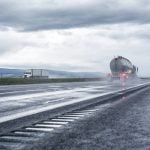My friend Ewan and I were sitting together as we travelled from the headquarters of the Hassad Group through the Qatari desert to their farming operations. Hassad has a sole vision of food security for the nation of Qatar, and their reach is global in context. Their mission is, “To own, develop and operate efficient, profitable, and growth-orientated global business brands that contribute to the welfare of Qatar and other societies, using efficient technology in harmony with the environment, and adhering to the highest standards of corporate social responsibility.”
Read Also

Mosquito-borne virus could be devastating to sheep breeding operations
Cache Valley virus, a mosquito-borne disease that infects small ruminants, could be a devastating hit to small operations.
To simplify such a large vision, let me just say that not only do they water the desert to produce food and feed, but they also invest in large tracts of land in Australia, Sudan, Kazakhstan, South America, and soon in Canada for the purpose of owning wheat, rice, sugar, poultry and rice.
The reach of Hassad and the wealth of Qatar was a little surreal as we had just arrived from the New Delhi slums and were now being hosted by a nation of excessive wealth.
Qatar is a conservative Arab nation that is highly protective of its culture and wealth. The government is preparing to feed its own and to protect it by developing food bunkers in the desert. The excessive heat (it was 47 C) and humidity were almost overwhelming as we stood in the middle of an unprotected barren landscape surrounded by a green oasis of Qatari hay.
The most valuable crop in Qatar is fodder (hay as we call it) for the dairy division and to sell to farmers so they may expand sheep and camel production. Depending on the variety, Hassad harvested nine to 13 crops per year resulting in 40-45 dry tonnes per hectare.
The dairy was being expanded to 40,000 head and was a complement to the glasshouse and flower operations that grew cash crops. As a note, many of the dairy operations that we visited were going to the 40,000-head mark, making dairy a source of beef for many nations.
Experienced traders
Asked about the openness in sharing information with our scholar group, a Hassad executive answered in direct terms that they had 38 generations of trading and we had four or five. They were trained and ready and could indeed beat us at the table. This was evident in the marketplace (souk). Walking through the souk brought those words to life as we carefully negotiated our prices without any baseline to assure us of a bargain.
Although the foreign women of Qatar hold executive positions, they are also confined to cultural norms and are very adherent to cultural expectations. Local women are covered in black, some completely, including the entire face. It was as though they were floating dolls — difficult to capture, protected from my camera, and perhaps secure in their cover. Again, my opinion would be limited to what I know and my growth comes from the discovery of the woman under the cover who lives in a world I could only begin to appreciate by being in that place at that time.
Executive women wore modest and flattering clothing inside the office. Qatari men, wear their spotless, long, white tunics with heads covered.
In four short weeks, I had gone from Canada through Australia to Singapore and through India and then to Qatar. At once I realized how limited I was by what I know and how liberation happens when we don’t know and must seek out the answers. Ewan and I talked about this in terms of what we were seeing and in the context of food security. Food security is not really about assets, but about arteries, and arteries only come from relationships, trades, deals, offering value and respecting values and a complete understanding to yourself and your client.
Food security then is a complex issue that goes beyond simply growing or storing more crop and seeing commodities. In the comfort of our own domain we think we know the world but that is only a mirage. The world must be seen, felt, tasted and explored for us to even begin to understand it.
If the desert can be green then what is it that we can do within agriculture in Alberta? If hay is the most valuable crop to another culture, what does that say about long-term agricultural growth and food systems? Perhaps to see the value in change we can look to Ontario where innovative farmers are growing crops specific to the foreign-born population. Better yet, we can look to ourselves for a moment of discovery and find our own green in the desert, not limited by what we know and ready to invest in the future.















